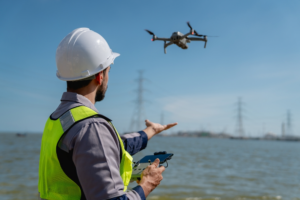The use of AI technology has become more important in various sectors, including audiovisual.
With the rise of AI voice technology, many professionals are considering implementing it in their audiovisual projects.
However, the question still arises as to which is better: an AI voice or a human voice-over?
In this blog post, we’ll explore the pros and cons of using an AI voice and a human voiceover on your audiovisual projects in a professional setting in 2023.
On the one hand, AI voices offer a level of convenience and efficiency in the production process, as they require less time and resources compared to hiring a human voice actor.
What’s more, the quality and consistency of an AI voice remains the same throughout the project, which can be advantageous for projects that require a large amount of narration or dialogue.
On the other hand, human voice-overs offer a level of authenticity and emotional connection with the audience that AI voices can lack.
Human voices can convey subtle nuances of tone, inflection and rhythm that are essential for creating a powerful impact on the viewer.
In addition, human voice-overs can be customized to meet the specific needs of a project, for example by incorporating regional accents or dialects.
However, the downside of using human voice-overs is the risk of inconsistency in terms of quality and availability.
Finding the right voice can be a time-consuming and costly process, and there’s always the risk of depending on a single person who may not be available for other projects.
Ultimately, the decision to use an AI voice or a human voice-over will depend on the specific needs and objectives of each project, as well as the resources available to the production team.
1. AI voice: consistent and effective.
AI voices deliver consistent and predictable results across audiovisual projects.
The technology maintains uniform tone and cadence throughout productions, strengthening brand identity and message continuity.
Modern AI voices master emotional expression and nuanced delivery, creating engaging audience experiences. The software learns and replicates complex speech patterns, delivering natural-sounding narration.
AI voice production accelerates project completion and reduces costs. Teams generate, edit, and finalize audio content rapidly without scheduling recording sessions or managing talent.
Note: While AI voices excel at consistency and efficiency, they still lack the authentic human warmth and natural personality that professional voice actors bring to projects.
The choice between AI and human narration depends on your project’s specific requirements, timeline, budget, and audience expectations. Consider these factors:
- Production speed requirements
- Budget constraints
- Brand personality goals
- Emotional connection needs
- Content volume
- Update frequency
Each option offers distinct advantages – AI voices prioritize efficiency and consistency, while human voices maximize authenticity and emotional impact.
2. Humans voices : authentic and expressive.
Human voices bring unmatched authenticity and expressiveness to professional audiovisual projects.
Human voices naturally transmit emotions and nuances that artificial voices struggle to reproduce.
Professional narrators infuse personality, warmth, and character into your project, which captivates your audience more effectively. They actively adapt their tone, rhythm, and accent to match the desired context and mood.
These elements create lasting impressions on your audience and significantly increase your project’s chances of success.
Practical considerations:
- Booking conflicts may arise
- Professional narrators command higher costs
- Production requires extended timelines
- Schedule management demands precise coordination
3. AI voice: personalization and scalability.
One of the advantages of using an artificial voice for audiovisual projects is the ability to personalize and adapt content.
With an AI voice, it’s possible to create personalized content for individual users and audiences based on their preferences, demographics and behavior.
AI technology can analyze data and generate unique content in real time, delivering a personalized experience for every user.
What’s more, the scalability of AI technology means that large amounts of content can be created in a short space of time, making it an effective solution for companies with tight deadlines or limited resources.
However, it’s essential to note that AI voices can still lack the natural intonation and emotional depth of a human voiceover, which can affect the overall quality of the audiovisual project.
It is therefore essential to carefully weigh up the advantages and disadvantages of using an AI voice and a human voice-over, depending on the specific needs and objectives of the project.
4. Human voice: emotional connection and nuance.
The human voice has always been a powerful communication tool, creating an emotional connection between speaker and listener.
Unlike AI-generated voices, a human voiceover can convey nuanced emotions, tone and timing that perfectly match the intended message of the audiovisual project.
This is particularly important in professional settings, where the tone and mood of the project directly influence the audience’s perception of the brand or organization.
A human voice-over can inject personality and authenticity, making the project more accessible and appealing.
However, using a human voiceover can also have its drawbacks, such as cost and availability.
A professional voiceover artist may require a higher fee, and finding the right actor with the perfect tone and interpretation can be time-consuming.
Nevertheless, the advantages of using a human voice-over, particularly the emotional connection and nuance, should not be overlooked when considering the success of an audiovisual project in a professional setting.
5. Artificial voice: cost-effective and fast.
One of the advantages of using artificial voice-overs for audiovisual projects in a professional context is their cost-effectiveness and speed.
Thanks to advances in AI technology, creating an artificial voiceover has become increasingly accessible and affordable.
This means that companies can save the cost of hiring an actor or dubbing artist.
Another advantage is the speed with which voice-overs can be generated.
With an AI voice, there’s no need to wait for a human actor to become available, or to schedule recording sessions.
This can significantly reduce production time and enable faster delivery of the final product.
However, it’s important to note that not all AI voices are created equal, and some may sound robotic or unnatural, which can have a negative impact on the overall quality of the audiovisual project.
6. Human voice: high quality and memorability.
When it comes to audiovisual projects, the human voice offers a level of quality and memorability that an artificial voice simply can’t match.
A human voiceover has the ability to convey emotions and nuances that an artificial voice simply can’t reproduce.
This is particularly important for projects that require a personal touch, such as commercials, documentaries and corporate videos. Viewers are more likely to remember and engage with content presented by a human voice, as it creates a stronger connection and leaves a lasting impression.
What’s more, a professional voice actor can offer a level of expertise and experience that an artificial voice cannot, ensuring a polished and effective end product.
However, it’s important to note that using a human voiceover can come at a higher cost and require more time for recording and editing, which are important factors to consider when choosing between an AI voice and a human voice.
7. AI voice: limited intonation and inflection.
When it comes to audiovisual projects in a professional setting, one of the important questions is whether to use an AI voice or a human voice-over.
Although AI technology has come a long way in recent years, it’s important to consider the limitations of AI voices compared to human voice-overs.
One particular drawback of AI voices is their limited ability to convey emotion through intonation and inflection.
Although AI voices may be able to read a script accurately, they lack the nuance and emotion that a human voiceover can provide.
This limitation can be particularly important in projects where the tone and emotional impact of the audio is a key factor in the project’s success.
8. Human voice: time-consuming and costly.
When it comes to audiovisual projects, the choice between using an AI voice and a human voice-over can be a difficult one.
One of the main advantages of using a human voiceover is that it can add a level of authenticity and personality to your project that an AI voice simply can’t replicate.
However, it’s important to note that recording a human voice can be a time-consuming and expensive process.
A human voiceover requires hiring an actor, scheduling recording sessions and, possibly, renting a studio.
Not only is this time-consuming, but it can also represent a significant expense for small projects or companies with limited budgets.
What’s more, if changes or edits need to be made to the voiceover, this may require additional recording sessions and costs.
Ultimately, while human voice can add a certain level of quality to your audiovisual project, it’s important to weigh up the costs and time involved before making a decision.
9. Artificial voice: risk of errors.
One of the disadvantages of using an artificial voice in audiovisual projects is the risk of errors.
Although AI technology has come a long way in producing human-like voices, it still lacks the nuances and emotional variations that human voices naturally possess.
The result can be monotonous, robotic speech that can be unpleasant to listen to.
In addition, AI voices can mispronounce words or clash with accents and dialects, which can be particularly problematic in projects requiring technical or industry-specific terms.
Human voiceover artists, on the other hand, can deliver a more authentic and engaging performance, bringing a level of personality and emotion to the project that AI voices can’t replicate.
Ultimately, the decision to use an AI voice or a human voiceover in your audiovisual project should depend on the specific needs of the project and the preferences of the target audience.
10. Human voice: requires professional expertise.
When it comes to creating audiovisual projects, the human voice brings a level of professionalism and expertise that cannot be reproduced by an artificial voice.
Nuances of tone, intonation and inflection are difficult for machines to imitate, and a human voice actor can bring a level of emotion and authenticity to a project that is difficult for AI to replicate.
However, it’s important to note that a human voice-over requires professional expertise.
Not only do voice actors need to have a pleasing voice, they also need to have correct diction, pronunciation and enunciation to ensure that the message is conveyed clearly and effectively.
In addition, a professional voice actor will be able to adapt his or her tone and delivery to the style and tone of the project, further enhancing its impact.
Although the use of AI voices can be more cost-effective and efficient, the advantages of using a human voice-over cannot be overestimated in a professional setting.
In conclusion, the use of AI voices and human voice-overs has both advantages and disadvantages in audiovisual projects.
While AI voices offer cost savings and the ability to customize a voice for a specific project, they can lack natural inflection and emotion, which is not the case with human voice-overs.
On the other hand, human voice-overs may be more expensive and time-consuming to produce, but their ability to convey emotion and establish a personal connection with viewers can have a significant impact on a project’s success.
Ultimately, the decision to use an AI voice or a human voice-over should be based on the specific needs and objectives of the project, as well as the target audience and the message to be conveyed.


